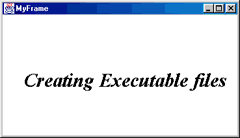![]() The
value of the Main-Class attribute must not have the .class
extension appended to the class name.
The
value of the Main-Class attribute must not have the .class
extension appended to the class name.
![]()
Doctor: Don't worry, after the operation, you will become a new man."
Patient: "Wonderful, will you send the bill to the old man."
![]()
A medical student was preparing a report on![]() frogs. He cut one leg and said, "Jump." The frog jumped. He cut the
second leg and said, "Jump." The frog jumped again. He cut third leg
and said, "Jump." The frog jumped. Then he cut the fourth leg and said,
"Jump." The frog didn't jump. He shouted repeatedly, but the frog didn't
jump. In his report he wrote: "After cutting all the legs, a frog becomes
deaf."
frogs. He cut one leg and said, "Jump." The frog jumped. He cut the
second leg and said, "Jump." The frog jumped again. He cut third leg
and said, "Jump." The frog jumped. Then he cut the fourth leg and said,
"Jump." The frog didn't jump. He shouted repeatedly, but the frog didn't
jump. In his report he wrote: "After cutting all the legs, a frog becomes
deaf."
![]()
A married man to his friend: "The most effective way to remember
your wife's ![]() birthday is to forget it once."
birthday is to forget it once."
![]()
John: "You look just like my wife. The only difference is that of a beard and moustache."
Ron: "But I don't have a beard or moustache."
John: "You don't, but my wife does."
 The Main-Class Attribute
The Main-Class Attribute
This attribute is used by stand-alone applications that are bundled into executable jar files, which can be invoked by the Java runtime directly. The value of this attribute defines the relative path of the main application class that the launcher will load at startup time. The value must not have the .class extension appended to the class name.
 Creating Executable
JAR file
Creating Executable
JAR file
c:\myframe>jar cmf MyFrame.mft MyFrame.jar *.class
Open the windows explorer and double click the "MyFrame.jar" file. If nothing goes wrong, you will see the following:

 Options
Options
c - Creates a new or empty archive on the standard
output.
f - It specifies a jar file to process. In the
case of creation, this refers to the name of the jar file to be created.
m - Include manifest information from specified
pre-existing manifest file.
In this chapter, I have shown you how to create executable Java archives. In the next chapter, you will learn how to invoke the DOS command interpreter.


